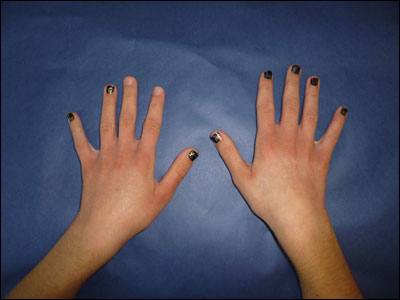A 13-year-old female with dry itchy rash on her hands
Click Here to Manage Email Alerts
A 13-year-old female presents to pediatric dermatology clinic for evaluation of a dry itchy rash on both of her hands. She has had this condition for the past 3 years and has not been able to get it under control. She is currently applying fluocinonide ointment twice a day and under occlusion at night. With this regimen, she gets some improvement but not complete resolution of her rash and continues to get repeated flares. In the past, she has tried triamcinolone ointment and tacrolimus ointment with similar results.
The patient does not feel she washes her hands too frequently; however, upon further questioning, it is discovered that she washes her hands a minimum of 10 times every day. Mom notes she only purchases the “safest” products for her daughter and that all her hand soaps are antibacterial. Aside from the prescribed ointment, the patient does not apply any other product or emollient to her hands. The patient is otherwise healthy and is not taking any medication.

Andrew Krakowski

Shehla Admani
On physical exam, she is noted to have eczematous red papules and plaques overlying her metacarpophalangeal joints and on her interdigital web spaces. She did not have any fissures, crusting or vesicles.
Can you spot the rash?
A. Pompholyx (dyshidrosis)
B. Allergic contact dermatitis
C. Psoriasiform dermatitis
D. Irritant contact dermatitis
E. Atopic dermatitis
Diagnosis: Irritant contact dermatitis
Hand dermatitis is a common complaint in both the primary care and dermatology settings. It can be caused by a variety of clinical entities, including contact dermatitis, psoriasiform dermatitis, atopic dermatitis and pompholyx. There are two main forms of contact dermatitis, irritant and allergic. Contact dermatitis can present as a rash at the site of exposure to an irritant or allergen. Symptoms can include pruritus, tenderness, or a burning or stinging sensation. The timing of the development of the rash is related to the subtype of the patient’s contact dermatitis.
Allergic vs. irritant contact dermatitis
Allergic contact dermatitis (ACD) is a type IV, delayed-type, T-cell-mediated, hypersensitivity reaction. ACD can present as nummular hand eczema, fingertip dermatitis or pulpitis, and in some cases vesicular lesions can also be seen. Typical contact allergens include nickel, chromate, rubber additives and preservatives. Although patch testing is the gold standard for diagnosis, history of exposure to the allergen in question is necessary in determining the clinical relevance of patch test results.
Once a true contact allergy is identified, patients should be counseled on allergen avoidance, as this is the key to managing this condition. A clue to distinguishing ACD from irritant contact dermatitis (ICD) is that in cases of ACD, the eczematous eruption can spread to other unexposed parts of the body. In contrast, the eruption with ICD remains localized to areas of direct contact with the offending agent.

Hand dermatitis in the "apron" distribution (involving the web spaces) and extending to dorsal surfaces of the distal hand and proximal fingers.
Image: Funk A
ICD is much more common than ACD and results from direct skin exposure to irritants such as soaps, detergents, disinfectants and water. Patients with a history of atopic dermatitis and/or those with filaggrin gene mutations have a higher susceptibility toward developing ICD. Several morphologic subtypes of irritant hand dermatitis exist, including the “apron” pattern, which consists of localized involvement of the finger webs with extension onto the dorsal and ventral surfaces of the hands. Topical corticosteroids, such as triamcinolone and fluocinonide, can be used to calm the inflammation in ICD; however, the key to treatment is to prevent further irritation and to repair the skin barrier.
There are two main options to minimize exposure to irritants: the first is to eliminate their use; however, if that is not possible, the next option is to create a physical barrier with either a barrier cream or the use of protective gloves.
Proper hand hygiene
Practicing proper dry skin care is the mainstay of management in patients with ICD. Hands should be washed with lukewarm or cool water. Cleansers should be fragrance free and antibacterial soaps should be avoided because these can be very harsh on the skin and strip the skin of its natural moisture. Emollients should be applied several times a day and especially after each hand washing. Emollients can help with symptomatic control and also to repair the skin barrier. Petrolatum-based emollients (such as Vaseline [Unilever] and Aquaphor [Beiersdorf]) are highly effective; alternatively, emollients containing skin-related lipids can also be used. In more severe cases, or those which are difficult to control, emollients can be applied and left on overnight under occlusion with white cotton gloves.
Patient history important
ACD and ICD of the hands can be difficult to differentiate; however, clues to the diagnosis can be found in the patient’s history, as well as in the distribution and characteristics of the rash. The patient in our case had a dermatitis in the “apron” distribution in addition to a history of frequent hand washing and infrequent moisturizing (a bad combination!). These clinical features led us to a suspicion of ICD.
To exclude any potential allergic component to the patient’s rash, patch testing was performed and was found to be negative. After switching to a mild soap, increasing use of emollients and applying a barrier prior to contacting potential irritants, the patient’s hand dermatitis was much improved and she was able to keep it under control and minimize the use of topical corticosteroids.
References:
Molin S. Clin Exp Dermatol. 2011;36:595-601.
Kucharekova M. Contact Dermatitis. 2003;48:293-299.
Visser MJ. Br J Dermatol. 2013;168:326-332.
Warshaw EM. Dermatol Ther. 2004;17:240-250.
For more information:
Sharon E. Jacob, MD, and Andrew C. Krakowski, MD, are attending physicians at Rady Children’s Hospital, San Diego.
Disclosure: Admani and Krakowski report no relevant financial disclosures.
